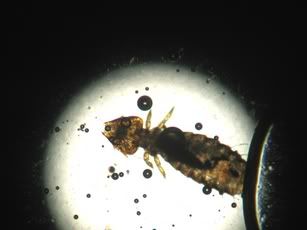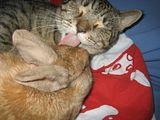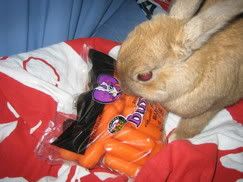I found this on a float yesterday :
(for those of you who just HAD to know :
the fecal sample came from a young male cat that came in for a neuter. He also had roundworms--sorry no pictures of those, I'll post worm pictures another time I promise!! )

According to Kristen, our friend up there is a biting louse. So, Curtesy of Gordon's Mallophaga Page(http://www.earthlife.net/insects/mallopha.html) here is everything you ever wanted to know (and more) about biting lice. (That was a good guess though Joey--you should take the stupid test)

The Biting Lice (Mallophaga)
The Mallophaga are described as wingless (Apterous), hemimetabolous (having a simple metamorphosis i.e. no pupa) ectoparsites (living on the outside of their hosts) of mostly birds but also of some mammals. The range in size from 0.5 to 10 mm long. Their mouthparts are designed for biting.
Most feed on fragments of hair and feathers. Some have formed a symbiotic relationship with bacteria, these may help with the digestion of blood etc as individuals deprived of their bacteria die in a few days. They are often adapted to live on particular parts of their hosts bodies. They can only survive for a maximun of three days after their host has died and may hitch a ride on a pasing fly (phoresis) in the hope of reaching a new host, they may also use phoresis in order to spread to a new host even if the present one is still alive.
Females lay up to 100 eggs which are cemented to the hair or feathers of the host with a clear fast drying glue which is secreted onto the hair or feather by the female immediately before she lays the egg. The eggs take about 3 or 4 days to hatch and the nymphs go through 3 larval instars in about 20 days before they reach maturity.


2 comments:
kljmlvjlk lvk;lof;olvfg !!!!!
This is the genus & species of that mite (?)
what species of animal was that fecal float?
Post a Comment